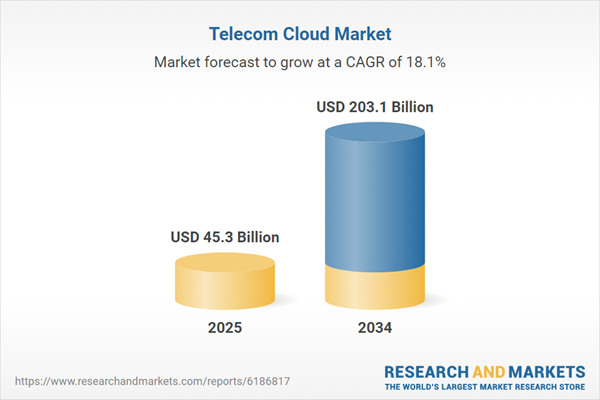The Telecom Cloud Market is reshaping the global telecommunications industry by offering scalable, flexible, and cost-efficient infrastructure for managing network operations, service delivery, and IT workloads. This market involves the integration of cloud computing technologies - public, private, and hybrid - into telecom ecosystems to enable virtualization, automation, and orchestration of services. By migrating core network functions, such as BSS (Business Support Systems), OSS (Operational Support Systems), and even radio access networks (RAN), to the cloud, telecom operators are able to improve agility, reduce operational costs, and introduce new services with shorter lead times. The telecom cloud enables support for 5G, IoT, and edge computing applications by facilitating dynamic resource allocation, intelligent network slicing, and real-time analytics. Leading technology providers including Amazon Web Services, Microsoft Azure, Google Cloud, IBM, and VMware are heavily investing in cloud-native solutions tailored to telecom service providers. As telcos embrace digital transformation, the telecom cloud has become a fundamental enabler of next-generation connectivity and service innovation.
The telecom cloud market witnessed a marked acceleration in deployment and innovation, primarily fueled by the rapid global expansion of 5G and the increasing demand for cloud-native architectures. Telecom operators significantly scaled up their investment in virtualized infrastructure, shifting more core network functions and customer management systems to cloud platforms. Key telecom players formed strategic alliances with hyperscale cloud providers to co-develop industry-specific solutions for network automation, container orchestration, and data lifecycle management. The year also saw a surge in the adoption of Network Function Virtualization (NFV) and Software-Defined Networking (SDN), which offered improved network flexibility and resource utilization. Furthermore, telecom cloud services played a vital role in enabling smart city applications, autonomous transport systems, and remote healthcare services. As geopolitical tensions and regulatory constraints intensified, many operators turned toward hybrid and sovereign cloud solutions to maintain compliance and protect national digital infrastructure. Edge cloud deployments also gained momentum, especially in high-density urban areas, to ensure ultra-low latency for time-sensitive applications.
The Telecom Cloud Market is expected to transition toward more intelligent, decentralized, and autonomous network environments. The growing need for hyper-personalized connectivity experiences - driven by innovations in AR/VR, autonomous systems, and mission-critical IoT - will place greater emphasis on cloud-native and edge-native architectures. Telecom operators will increasingly focus on implementing AI-powered network management systems, enabling predictive maintenance, traffic optimization, and energy-efficient resource allocation. Multi-cloud strategies will be more prominent as operators seek to avoid vendor lock-in and optimize cost-performance ratios across varied service verticals. Private 5G networks, enabled by telecom cloud platforms, will become more prevalent across manufacturing, logistics, and defense sectors. Additionally, quantum computing integration into telecom clouds may begin to surface in research and pilot projects, offering immense potential for cybersecurity and advanced processing. Compliance with emerging cross-border data transfer laws, coupled with the pressure to ensure zero-trust security architectures, will require operators to rethink how telecom cloud environments are governed and deployed on a global scale.
Key Insights: Telecom Cloud Market
- Edge cloud expansion is becoming central to telecom strategies, offering ultra-low latency and localized compute capabilities for real-time applications like smart manufacturing, autonomous mobility, and immersive media experiences.
- Network slicing powered by telecom cloud platforms is enabling service providers to create customizable, SLA-driven connectivity experiences for enterprise customers in sectors like healthcare, energy, and automotive.
- AI and ML integration into telecom cloud is transforming network management, enabling automated traffic routing, fault prediction, and resource optimization at scale without constant human intervention.
- Telecom operators are adopting hybrid and multi-cloud strategies to maintain operational flexibility, data residency compliance, and reduce reliance on single cloud vendors amid growing geopolitical uncertainties.
- Open RAN (Radio Access Network) is gaining traction within the telecom cloud ecosystem, facilitating vendor-neutral deployments and encouraging innovation in radio access services through virtualized and disaggregated components.
- The global rollout of 5G and the need for scalable infrastructure to support high-speed, low-latency services is a major catalyst for telecom cloud adoption across core and edge network environments.
- Growing demand for digital services - including OTT content, mobile financial platforms, and connected devices - is prompting telecoms to adopt cloud to deliver these at scale with reduced time-to-market.
- Rising operational costs and shrinking ARPU (Average Revenue Per User) are compelling operators to shift from legacy systems to cloud-native platforms that offer automation and cost-efficiency.
- Regulatory pressures around data sovereignty, cybersecurity, and lawful interception are pushing operators to adopt secure, regionally compliant telecom cloud solutions with built-in governance tools.
- One key challenge is managing the complexity of transitioning from legacy infrastructure to cloud-native architectures, which involves high initial costs, skills gaps, and operational disruptions during migration.
Telecom Cloud Market Segmentation
By Type
- Public Cloud
- Private Cloud
- Hybrid Cloud
By Computing Service
- Infrastructure As A Service (IaaS)
- Platform As A Service (PaaS)
- Software As A Service (SaaS)
By Organization Size
- SMEs
- Large Enterprise
By Application
- Data Storage
- Achieving
- Computing
- Enterprise Application
- Other Applications
By End users
- BFSI
- Retail
- Manufacturing
- Transportation and Distribution
- Healthcare
- Government
- Media and Entertainment
- Other End Users
Key Companies Analysed
- Microsoft Corporation (Azure for Operators)
- Amazon Web Services (AWS Telecom Solutions)
- Google Cloud Platform (GCP Telecom Solutions)
- IBM Corporation
- Oracle Corporation
- Ericsson
- Nokia Corporation
- Huawei Technologies Co., Ltd.
- VMware, Inc.
- Salesforce, Inc.
Telecom Cloud Market Analytics
The report employs rigorous tools, including Porter’s Five Forces, value chain mapping, and scenario-based modeling, to assess supply-demand dynamics. Cross-sector influences from parent, derived, and substitute markets are evaluated to identify risks and opportunities. Trade and pricing analytics provide an up-to-date view of international flows, including leading exporters, importers, and regional price trends.
Macroeconomic indicators, policy frameworks such as carbon pricing and energy security strategies, and evolving consumer behavior are considered in forecasting scenarios. Recent deal flows, partnerships, and technology innovations are incorporated to assess their impact on future market performance.Telecom Cloud Market Competitive Intelligence
The competitive landscape is mapped through proprietary frameworks, profiling leading companies with details on business models, product portfolios, financial performance, and strategic initiatives. Key developments such as mergers & acquisitions, technology collaborations, investment inflows, and regional expansions are analyzed for their competitive impact. The report also identifies emerging players and innovative startups contributing to market disruption.
Regional insights highlight the most promising investment destinations, regulatory landscapes, and evolving partnerships across energy and industrial corridors.Countries Covered
- North America - Telecom Cloud market data and outlook to 2034
- United States
- Canada
- Mexico
- Europe - Telecom Cloud market data and outlook to 2034
- Germany
- United Kingdom
- France
- Italy
- Spain
- BeNeLux
- Russia
- Sweden
- Asia-Pacific - Telecom Cloud market data and outlook to 2034
- China
- Japan
- India
- South Korea
- Australia
- Indonesia
- Malaysia
- Vietnam
- Middle East and Africa - Telecom Cloud market data and outlook to 2034
- Saudi Arabia
- South Africa
- Iran
- UAE
- Egypt
- South and Central America - Telecom Cloud market data and outlook to 2034
- Brazil
- Argentina
- Chile
- Peru
Research Methodology
This study combines primary inputs from industry experts across the Telecom Cloud value chain with secondary data from associations, government publications, trade databases, and company disclosures. Proprietary modeling techniques, including data triangulation, statistical correlation, and scenario planning, are applied to deliver reliable market sizing and forecasting.Key Questions Addressed
- What is the current and forecast market size of the Telecom Cloud industry at global, regional, and country levels?
- Which types, applications, and technologies present the highest growth potential?
- How are supply chains adapting to geopolitical and economic shocks?
- What role do policy frameworks, trade flows, and sustainability targets play in shaping demand?
- Who are the leading players, and how are their strategies evolving in the face of global uncertainty?
- Which regional “hotspots” and customer segments will outpace the market, and what go-to-market and partnership models best support entry and expansion?
- Where are the most investable opportunities - across technology roadmaps, sustainability-linked innovation, and M&A - and what is the best segment to invest over the next 3-5 years?
Your Key Takeaways from the Telecom Cloud Market Report
- Global Telecom Cloud market size and growth projections (CAGR), 2024-2034
- Impact of Russia-Ukraine, Israel-Palestine, and Hamas conflicts on Telecom Cloud trade, costs, and supply chains
- Telecom Cloud market size, share, and outlook across 5 regions and 27 countries, 2023-2034
- Telecom Cloud market size, CAGR, and market share of key products, applications, and end-user verticals, 2023-2034
- Short- and long-term Telecom Cloud market trends, drivers, restraints, and opportunities
- Porter’s Five Forces analysis, technological developments, and Telecom Cloud supply chain analysis
- Telecom Cloud trade analysis, Telecom Cloud market price analysis, and Telecom Cloud supply/demand dynamics
- Profiles of 5 leading companies - overview, key strategies, financials, and products
- Latest Telecom Cloud market news and developments
Additional Support
With the purchase of this report, you will receive:- An updated PDF report and an MS Excel data workbook containing all market tables and figures for easy analysis.
- 7-day post-sale analyst support for clarifications and in-scope supplementary data, ensuring the deliverable aligns precisely with your requirements.
- Complimentary report update to incorporate the latest available data and the impact of recent market developments.
This product will be delivered within 1-3 business days.
Table of Contents
Companies Mentioned
- Microsoft Corporation (Azure for Operators)
- Amazon Web Services (AWS Telecom Solutions)
- Google Cloud Platform (GCP Telecom Solutions)
- IBM Corporation
- Oracle Corporation
- Ericsson
- Nokia Corporation
- Huawei Technologies Co. Ltd.
- VMware Inc.
- Salesforce Inc.
Table Information
| Report Attribute | Details |
|---|---|
| No. of Pages | 160 |
| Published | October 2025 |
| Forecast Period | 2025 - 2034 |
| Estimated Market Value ( USD | $ 45.3 Billion |
| Forecasted Market Value ( USD | $ 203.1 Billion |
| Compound Annual Growth Rate | 18.1% |
| Regions Covered | Global |
| No. of Companies Mentioned | 10 |









